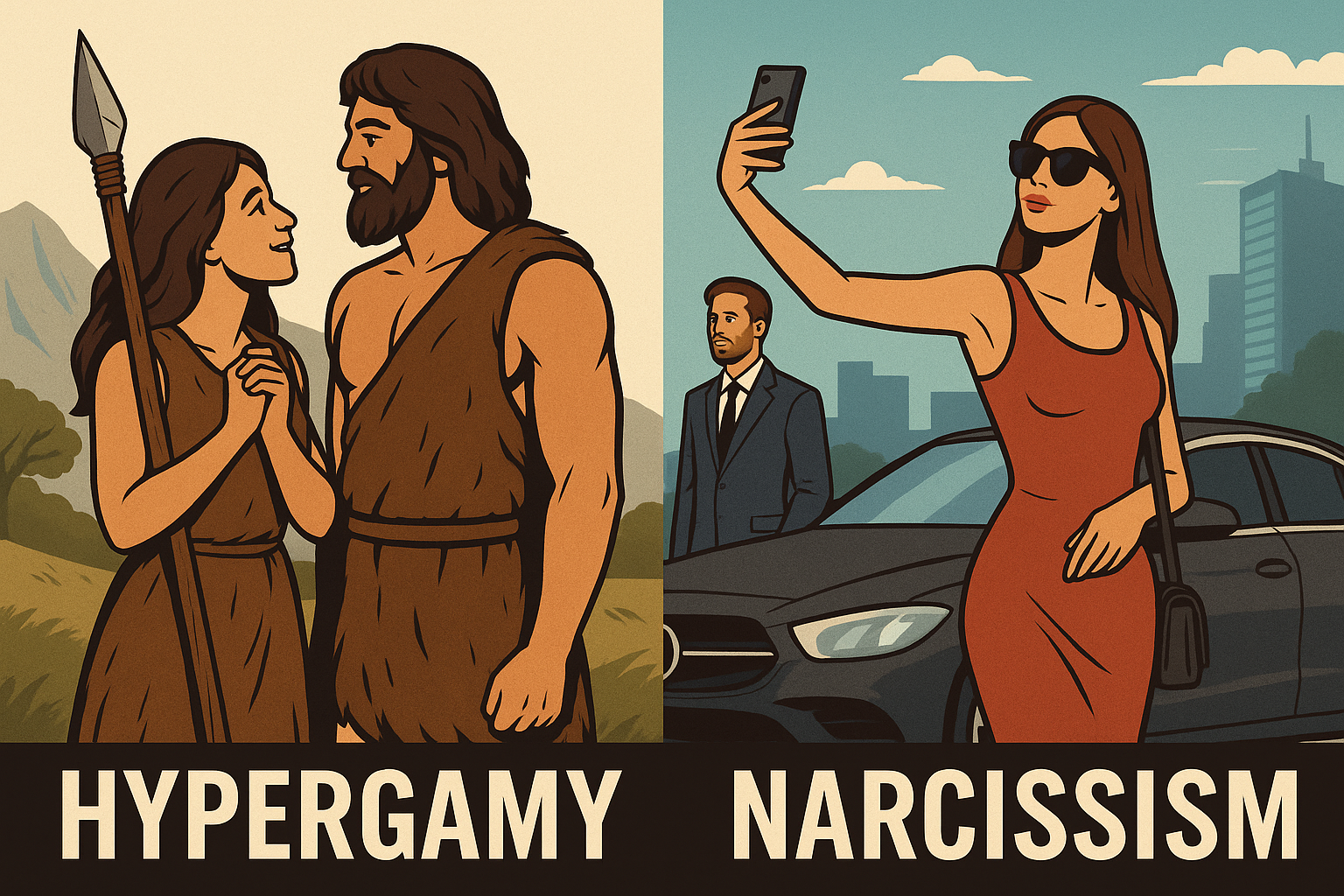Many commentators blame the rising female selectiveness in relationships on “hypergamy”—the idea that women naturally seek partners of higher status. While this theory has evolutionary grounding, a more compelling explanation lies in cultural narcissism.
In affluent, individualistic societies, narcissistic traits have surged—particularly among women raised in a culture that glorifies self-worth, esteem, and chivalric deference. This acquired status leads to what psychologists call Acquired Situational Narcissism, a form of narcissism born not from personality disorder, but from social reinforcement of perceived importance. Much of what’s labeled “hypergamy” today may in fact be status-seeking motivated by this cultural narcissism, not a biologically adaptive mate strategy.
Research supports this view. Narcissists tend to choose romantic partners who boost their status—those who are attractive, wealthy, or high in social capital—not because of emotional closeness but to reflect glory and inflate self-esteem. They prefer “trophy partners,” idealized mates who mirror their inflated self-image. These patterns of self-enhancing relationship selection are well-documented and correlate strongly with narcissistic motivations rather than with functional reproductive strategy.
“Narcissists are more likely to choose relationships that elevate their status over relationships that cultivate affiliation… They often demonstrate an increased preference for high-status friends and trophy partners, perhaps because they can bask in the reflected glory of these people.”
— Grapsas et al., 2020
“Narcissists seek romantic partners who offer self-enhancement value either as sources of fawning admiration, or as human trophies (e.g., by possessing impressive wealth or exceptional physical beauty).”
— Wallace, 2011
“Narcissists’ preference for romantic partners reflects a strategy for interpersonal self-esteem regulation… These partners were more likely to be seen as a source of self-esteem to the extent that they provided the narcissist with a sense of popularity and importance.”
— Campbell, 1999
“Narcissists particularly look for in a partner… physical attractiveness and agentic traits (e.g., status and success)… Indeed, narcissists report that part of the reason they are drawn to attractive and successful partners is that these people are similar to them.”
— Campbell, Brunell & Finkel, 2006
True evolutionary hypergamy does not require an individual to overrate their own attractiveness. Narcissism does. Thus, a useful test: if a woman dramatically overestimates her own desirability while seeking high-status men, this signals narcissism—not evolution. Mistaking the two leads to the normalization and even glorification of maladaptive traits under the guise of “natural female behavior.”
Moreover, modern narcissistic self-enhancement is not adaptive—it undermines relationship quality, social cohesion, and even fertility rates. Unlike adaptive mate strategies, it serves the ego, not survival.
By distinguishing narcissistic self-enhancement from evolutionary hypergamy, we avoid excusing destructive behavior as biologically inevitable. What we see today is not always nature—it’s culture, and it’s increasingly narcissistic.
References:
-
Grapsas, S., Brummelman, E., Back, M. D., & Denissen, J. J. (2020). The “why” and “how” of narcissism: A process model of narcissistic status pursuit. Perspectives on Psychological Science, 15(1), 150-172.
-
Wallace, H. M. (2011). Narcissistic self-enhancement. In: Campbell, W. K., & Miller, J. D. (Eds.) The Handbook of Narcissism and Narcissistic Personality Disorder: Theoretical Approaches, Empirical Findings, and Treatments, 309-318.
-
Campbell, W. K. (1999). Narcissism and romantic attraction. Journal of Personality and Social Psychology, 77(6), 1254–1270.
-
Campbell, W. K., Brunell, A. B., & Finkel, E. J. (2006). Narcissism, Interpersonal Self-Regulation, and Romantic Relationships: An Agency Model Approach. In: Vohs, K. D., & Finkel, E. J. (Eds.), Self and Relationships: Connecting Intrapersonal and Interpersonal Processes, 57–83.
Feature image detail: Left half shows a tribal or historical woman looking with admiration at a strong, competent man (symbolizing adaptive hypergamy). The right half shows a modern woman taking selfies next to a luxury car, barely noticing the man she’s with. Symbolism: Juxtaposes genuine evolutionary mate choice with modern narcissistic self-display.
